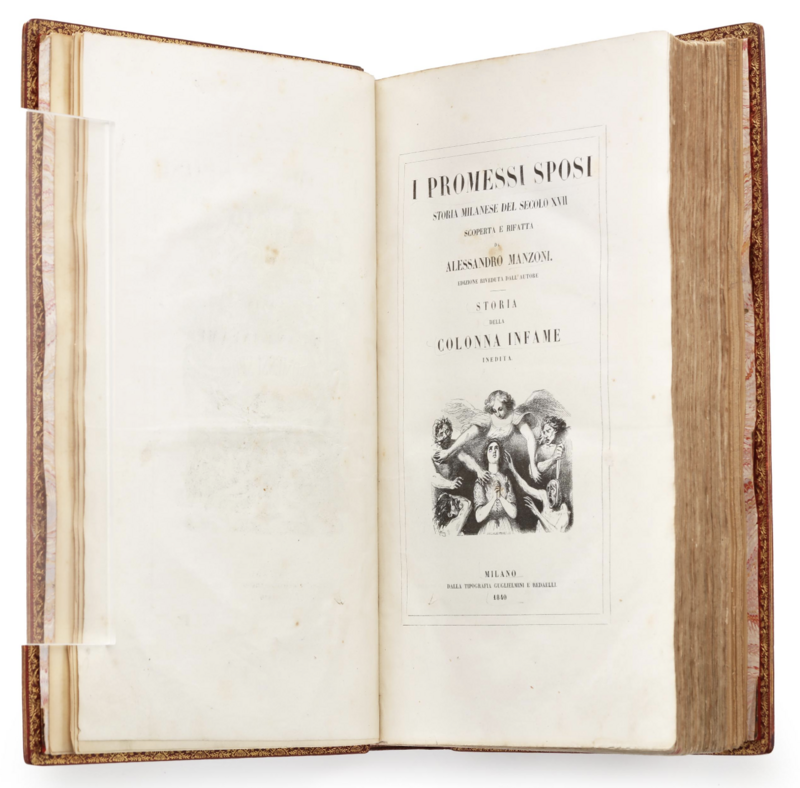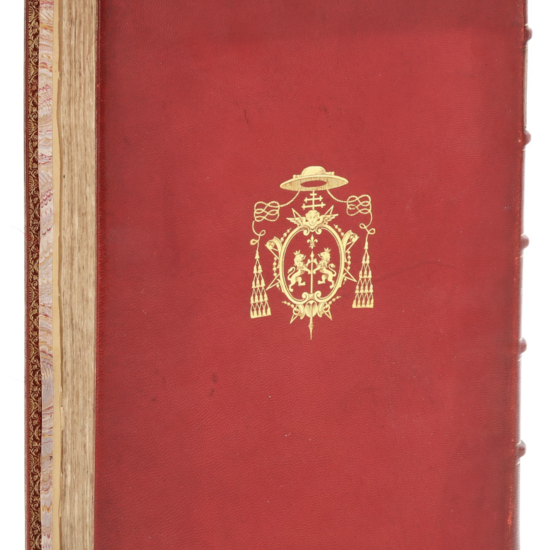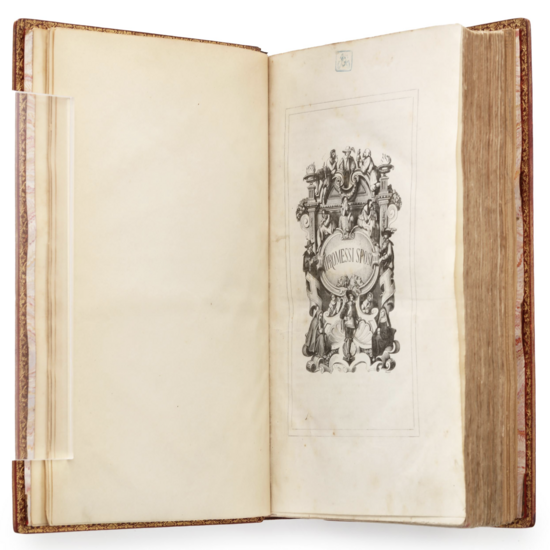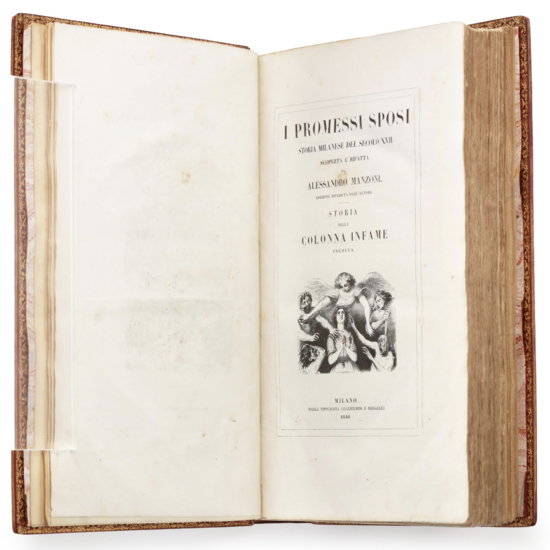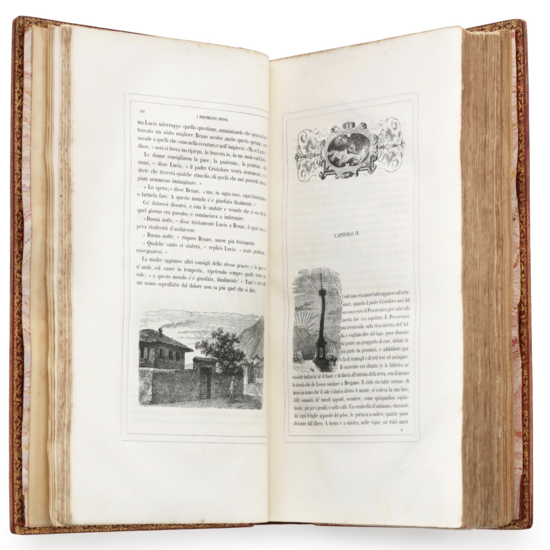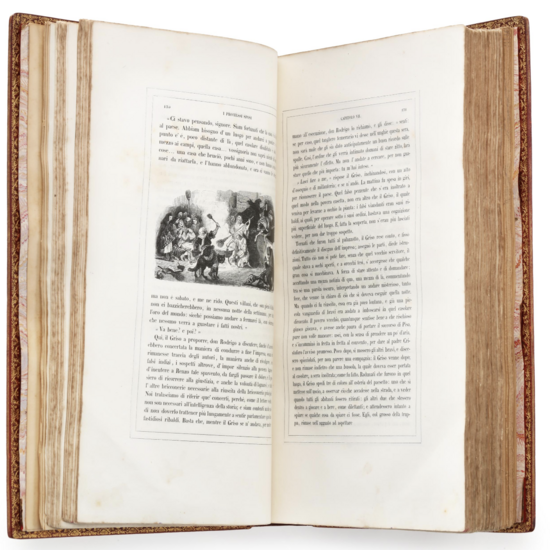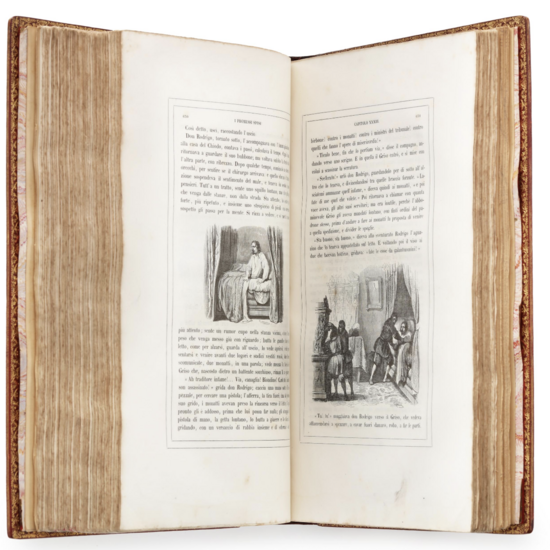THE FOUNDING NOVEL OF MODERN ITALIAN LANGUAGE - BOUND FOR A SICILIAN CARDINAL
4to (285x209 mm). 864 pp. With frontispiece, vignette on title page and 450 illustrations in text. Text within typographic frame. Late 19th-century gilt-tooled red leather, gilt and raised bands on spine, red satin and marbled paper endleaves, binding marked “Engel rel. Paris” (front joint repaired and darkened). Very good overall with light scuffing to boards, spine darkened, minor rubbing to joints, light to moderate foxing and toning throughout, fabric coming unglued in areas, small stamp on frontispiece, small tear to marbled endpaper, small hole on pp. 225/226 partially affecting the text but with no loss, bottom outer corner of p. 391 torn off, some offsetting of a few illustrations, bottom margin of a few leaves slighlty shorter than in others, bound with numerous blank leaves at the end. A good, wide-margined copy.
Provenance. On the panels gilt coat-of-arms of cardinal Mariano Rampolla del Tindaro (1843-1913). Born in Polizzi Generosa, near Cefalù, Sicily, the youngest son of Ignazio Rampolla, count of Tindaro, he studied at the Pontifical Gregorian University in Rome, where he earned a doctorate in utroque iure, was ordained priest in 1866, was appointed secretary of the S.C. Propaganda Fide for Oriental Rites in 1877 and 1880, and was elected titular archbishop of Eraclea and nuncio in Spain in 1882. Secretary of State from 1887 to 1903, he was created cardinal in 1887, grand prior of the Sacred and Sovereign Military Order of St. John of Jerusalem in 1896, and president of the Biblical Commission in 1902. He participated in the conclave of 1903, which elected Pope Pius X and during which Emperor Franz Joseph I of Austria-Hungary brought a veto against his election to the papacy. He was also elected president of the Roman Academy of St. Thomas Aquinas in 1910 and librarian and archivist of the Holy Roman Church in 1912. He died in Rome in 1913 (cf. J. LeBlanc, Dictionnaire biographique des cardinaux du XIXe siècle: contribution à l'histoire du Sacré Collège sous les pontificats de Pie VII, Léon XII, Pie VIII, Grégoire XVI, Pie IX et Léon XIII, 1800-1903, Montréal, 2007, p. 774-779; see also L. Trincia, Conclave e potere politico. Il veto a Rampolla nel sistema delle potenze europee, 1887-1904, Rome, 2004; and L. Trincia, J.-M. Ticchi, & L. Civinini, La figura e l'opera del cardinale Mariano Rampolla del Tindaro, Palermo, 2006). From the collection of Prof. Roberto Severino, Washington, D.C.
First edition of the final and defitinive version of most famous novel of the Italian literature, I Promessi Sposi, or ‘The Betrothed', whose cultural and linguistic impact on the formation of generations of Italians can hardly be underestimated.
After composing the tragedy Adelchi and the ode Cinque maggio (‘The Fifth of May'), Manzoni began in 1821 to work on a historical novel initially entitled Fermo e Lucia. The first draft of the novel was completed in September 1823. The following year Manzoni signed a contract with the publisher/editor Vincenzo Ferrario, one of the first in Italy to publish Walter Scott's novels, and obtained the imprimatur for his work, which had since been revised and renamed Gli sposi promessi (‘The Betrothed').
The first edition of the novel, although it bears the dates 1825-1826, was actually finished in June 1827 (hence the name “ventisettana” with which it is universally known), because of the continuous corrections of the author, who almost every day went to the Ferrario's workshop to read and modify the proofs. The success was striking: the two thousand copies of the print run on common paper and the few others on fine paper went sold out in less than two months and, as early as December 1827, with great despair of the author, appeared on the market eight pirate editions.
In July 1827, dissatisfied with the language of the novel, Manzoni moved with the whole family to Florence, where at the Gabinetto Vieusseux he found the help he sought for to clean up the text of ‘The Betrothed' from the too many Lombard terms. The so-called “risciacquatura in Arno” (‘rinsing in the Arno river') continued also later in Milan, where Manzoni worked on his novel for another ten years in search of what in his intention should have been the perfect Italian national language. In 1840 he finally made a contract with the publishers Guglielmini and Radaelli for the printing of the second official edition. To avoid the exceptional booming of counterfeits occurred after the release of the first edition, Manzoni decided to publish the work in a sumptuous edition, in a bigger format and accompanied by many illustrations in the text, with the purpose to make more difficult to counterfeit the volume. The illustrations, which were thought to clarify the narration and not just to embellish the book, were entrusted to the Turin painter Francesco Gonin, who designed most of them; the remaining are the work of Paolo and Luigi Riccardi, Massimo D'Azeglio, Giuseppe Sogni, Luigi Bisi, and Federico Moia.
The so-called “quarantana” edition (Milan, Guglielmini and Radaelli, 1840), the one offered here, includes for the first time the Storia della colonna infame (‘The History of the Infamous Column'), an historical essay written by Manzoni on the plague that hit Milan in 1630. This text is of key importance to better understand the novel and should always be issued together. The new edition was published at the author's expense and sold on subscription, but, in spite of Manzoni's great expectations, the whole operation proved a fiasco: of the ten thousand copies of the print run only the half was sold by subscriptions and Manzoni lost nearly half of the capital invested. Moreover, despite the precautions taken, soon began again the carousel of counterfeit editions (cf. L. Toschi, La sala rossa. Biografia dei ‘Promessi Sposi', Turin, 1989; see also V. Intonti & R. Mallardi, Cultures in Contact. Translation and Reception of ‘I Promessi Sposi' in 19th Century England, New York, 2011; and C. Povolo, The Novelist and the Archivist. Fiction and History in Alessandro Manzoni's The Betrothed, Basingstoke, 2014).
Alessandro Manzoni was born in Milan and was educated in strict religious colleges. He was the nephew, from his mother's side, of Cesare Beccaria, the author of Dei delitti e delle pene. In 1805 Manzoni joined his mother, Giulia Beccaria, in Paris, where he remained for several years and met, among others, Claude Fauriel, who had a long-lasting influence on his thinking.
In 1808 Manzoni married in Milan Henriette Blondel, the daughter of a Geneva banker of Calvinist faith, with whom he had ten children. Through the intermediation of the Jansenist priest Eustachio Degola, the couple converted to Catholicism. As a result of this conversion, Manzoni wrote the Inni Sacri (‘Sacred Hymns') and the treaty Osservazioni sulla morale cattolica (‘Observations on Catholic morality'). In 1820 he published his first tragedy, The Count of Carmagnola, which, as the following one, the Adelchi (1822), despite the praise received by Goethe, was never staged. Napoleon's death in 1821 inspired Manzoni to write the lyric poem The Fifth of May.
The loss of his wife in 1833 was followed by that of many of his children, including the eldest daughter Giulia, the wife of Massimo D'Azeglio. In January 1837 he got married a second time with Teresa Borri. He survived also this second wife and many of the children born into his first marriage; only two of them died after their father.
In 1860 Manzoni was appointed senator in the first parliament of unified Italy. As chairman of the parliamentary committee on the national language, in 1868 he wrote a short article on the Italian tongue, Dell'unità della lingua italiana e dei mezzi per diffonderla (‘On the unity of the Italian language and the means to spread it'), followed by a more extensive dissertation titled Appendice alla relazione intorno all'unita della lingua (‘Appendix to the report around the unity of the language', Milan, 1869). Beginning with the years in which he was revising the text of The Betrothed, Manzoni's interest for the language was always constant. He soon realized that the language spoken in Tuscany was to be adopted without reservations as the only true language of all Italians. Even before the appointment as chairman of the committee, he faced the issue not only at an aesthetic level, but also as a problem of national civil interest. Manzoni died of cerebral meningitis on May 22, 1873.
M. Parenti, Bibliografia manzoniana, Florence, 1936, p. 331; A. Vismara, Bibliografia manzoniana, Milan, 1875, 57.
[13017]



